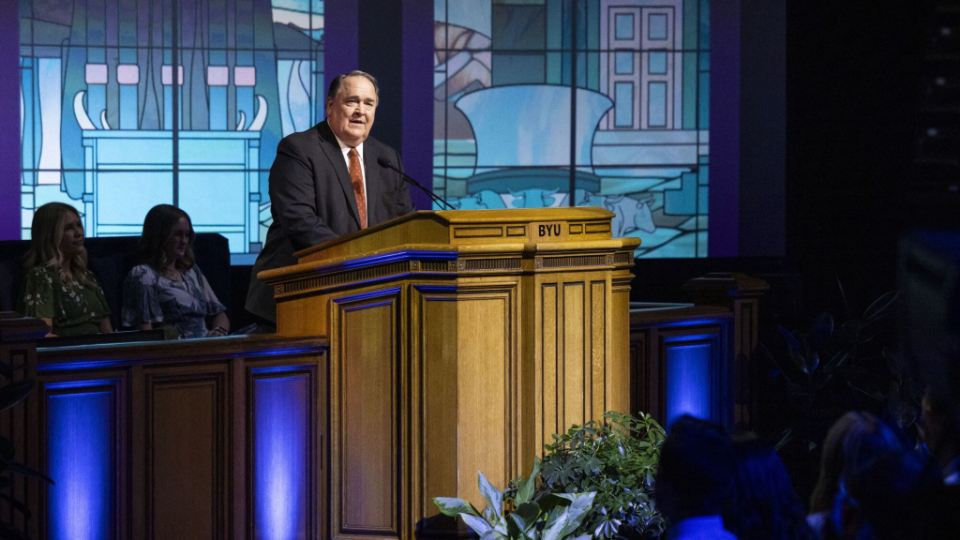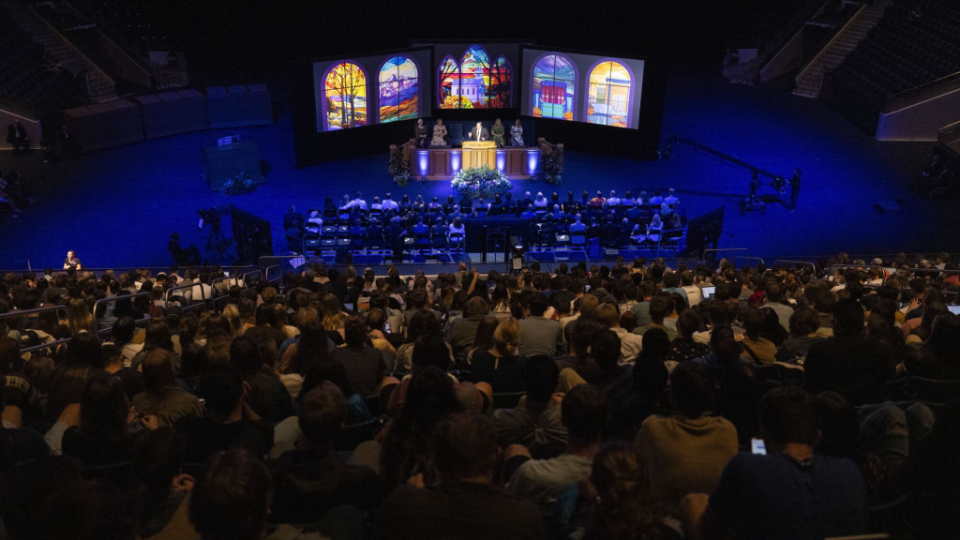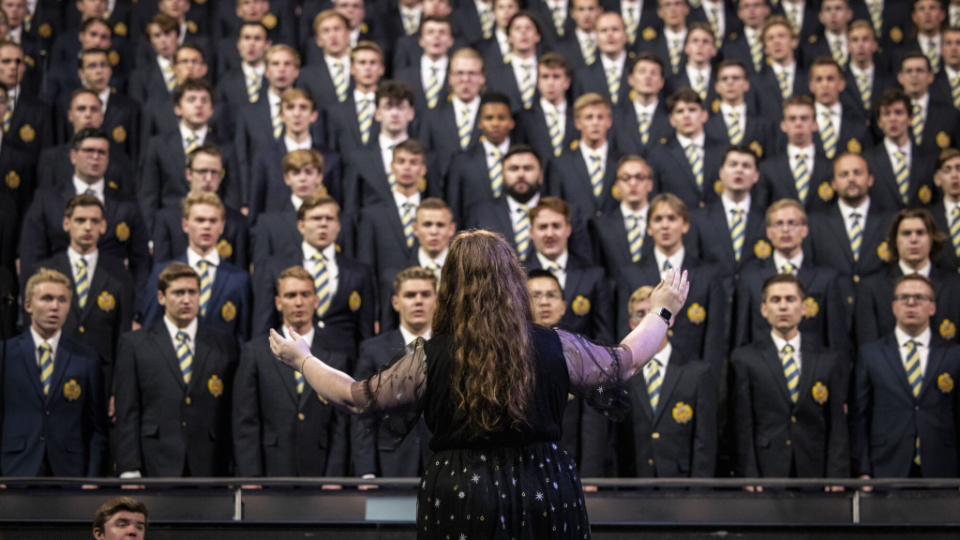
Elder-Haynie-at-BYU-provo
Elder Allen D. Haynie, General Authority Seventy, speaks about the temple during a BYU devotional in Provo, Utah, Tuesday, October 10, 2023. Photo by Joey Garrison, courtesy of Church News.All rights reserved.This story appears here courtesy of TheChurchNews.com. It is not for use by other media.
By Mary Richards, Church News
God is eager to enter into a covenant relationship with His children in His temple, taught Elder Allen D. Haynie, General Authority Seventy, at a devotional address at Brigham Young University on Tuesday, October 10.
Heavenly Father has always wanted and planned for a sacred space where He could instruct and make covenants with His children: in the Garden of Eden, the tops of mountains, Moses’ tabernacle, Solomon’s temple and temples today.
“We are invited as His guests into His house. He extends this invitation to us again and again,” Elder Haynie said. “... We should want to enter His house often because Jesus is anxious to meet with us there.”
Elder Haynie shared four challenges that may prevent people from fully benefiting from the temple experience.
1. Not Understanding the Scriptures
Elder Haynie said those seeking to understand and connect with ordinances in the house of the Lord in a more meaningful way should spend more time reading the scriptures that talk about the temple and temple ordinances.
For example, Leviticus 8:12: “And [Moses] poured of the anointing oil upon Aaron’s head, and anointed him, to sanctify him.”
1 Samuel 10:1, 6 reads: “Then Samuel took a vial of oil, and poured it upon [Saul’s] head, . . . and said . . . the Spirit of the Lord will come upon thee, and thou shalt prophesy with them, and shalt be turned into another man.”
And 1 Samuel 16:13 says: “Samuel took the horn of oil, and anointed [David] in the midst of his brethren; and the Spirit of the Lord came upon David from that day forward.”

Elder-Haynie-at-BYU-provo
Elder Allen D. Haynie, General Authority Seventy, speaks about the temple during a BYU devotional in Provo, Utah, Tuesday, October 10, 2023. Photo by Joey Garrison, courtesy of Church News.All rights reserved.2. Unworthiness
Going to the temple unworthily can hinder someone from receiving spiritual teaching about the Savior. Weekly participation in the ordinance of the sacrament can help people become and remain clean.
“Repentance is essential to temple revelation, and temple revelation is essential to the change that we all should experience from meeting Jesus in the temple,” Elder Haynie said.
3. Ritual and Symbolism
Perhaps the ritual and symbolic aspects of the ordinances were a little confusing and uncomfortable the first time. But that doesn’t mean people should abandon their efforts to understand what the Lord is trying to teach and bestow upon them.
“The beautiful symbolic aspects of temple ordinances can help us understand and feel the literal power of godliness inherent in those ordinances,” Elder Haynie said.
The ordinances in the temple were prepared by the Lord before the foundation of the world (Doctrine and Covenants 128:5).
As President Nelson taught in October 2021 general conference in his talk “The Temple and Your Spiritual Foundation”, “If you don’t yet love to attend the temple, go more often — not less.”
4. Failure to Seek Jesus
Elder Haynie said all the symbolism in the house of the Lord points towards Jesus Christ. He said people must seek Jesus while participating in temple ordinances.
“He is who our Father in Heaven desires us to meet in the temple. He is at the center of every symbol, every ordinance, every covenant, every hoped for blessing in the temple. Seeking Jesus in the temple enables us to understand why we are in the temple and why we should return,” Elder Haynie said.

Elder-Haynie-at-BYU-provo
The BYU Men’s Chorus sings before Elder Allen D. Haynie, General Authority Seventy, gives the BYU devotional in Provo, Utah, Tuesday, October 10, 2023. Photo by Joey Garrison, courtesy of Church News.All rights reserved.The Garment of the Holy Priesthood
Prior to leaving the Garden of Eden to face the challenges of mortality and the attacks of the adversary, Adam and Eve were given a coat of skins or a garment.
“The significance of the giving of a garment by God to His covenant children and the receiving and wearing of that garment by His covenant children should not be considered ordinary. It is a most sacred exchange,” Elder Haynie said.
Anciently, sacred clothing was worn by God’s covenant children. It is no different today, Elder Haynie said.
“What an amazing, sacred moment it is to be given a garment while in the house of the Lord, with all its symbolic meaning, the most important of which is a remembrance of the Savior’s sacrifice in the Garden of Gethsemane and on the cross and His glorious Resurrection,” Elder Haynie said.

Elder-Haynie-at-BYU-provo
Elder Allen D. Haynie, General Authority Seventy, gives a BYU devotional in Provo, Utah, Tuesday, October 10, 2023. Photo by Joey Garrison, courtesy of Church News.All rights reserved.Further information on ChurchofJesusChrist.org explains how the temple garment is a physical reminder of sacred promises made with Heavenly Father and the blessings He promises. The General Handbook Section 38.5.5 and Section 27.2 explain how the garment should be worn and that it also serves as a protection.
In conclusion, Elder Haynie said that in the temple, people can receive power to withstand and overcome the spiritual attacks of the adversary through the making and keeping of covenants. They can receive the garment of the holy priesthood.
“And in the temple, you can meet Jesus.”
